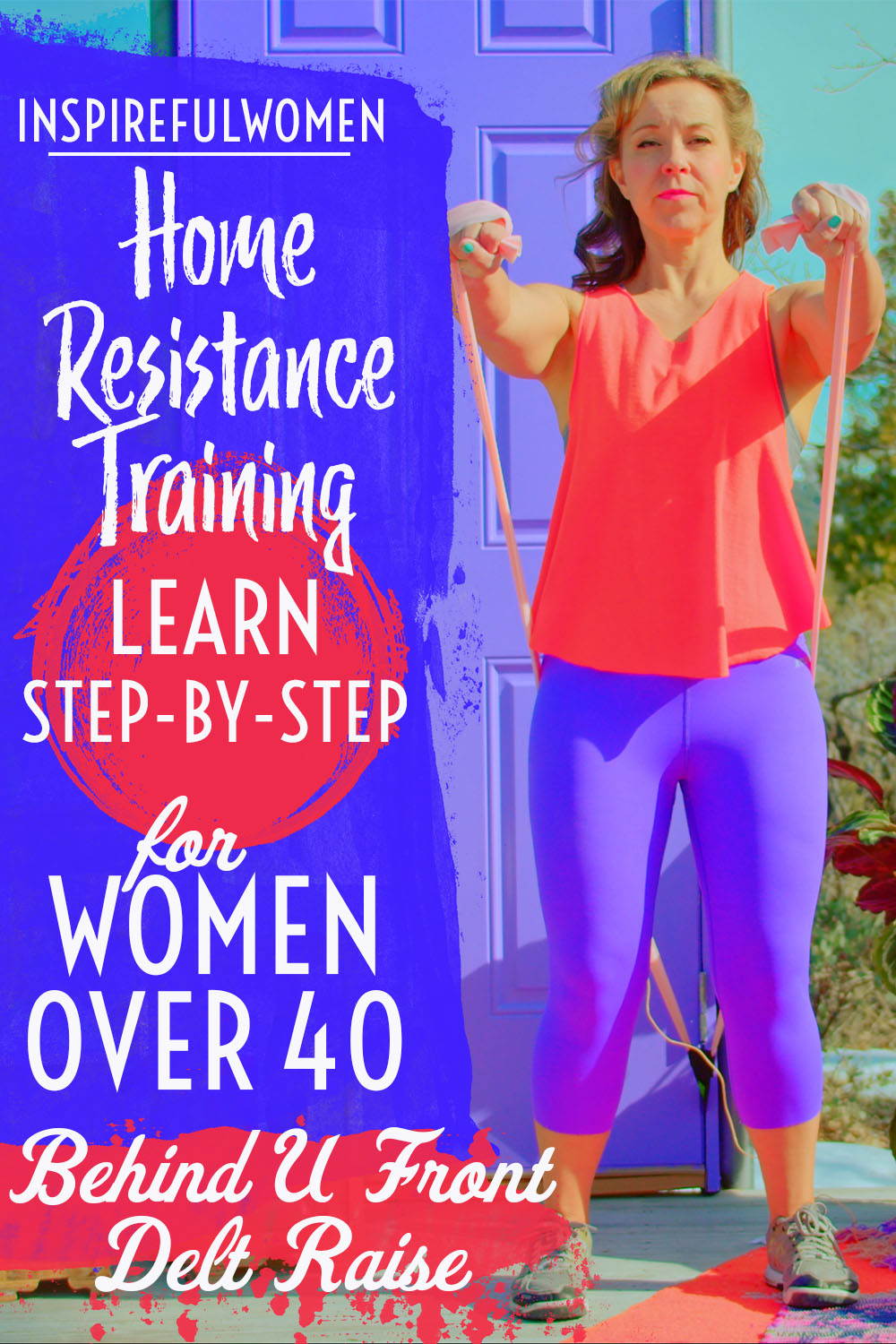Behind U Band Front Delt Raise
How to Do the Front Raise Variation - Band Behind U - Beginner Shoulder Exercise | In-Depth Guide [VISUAL LEARNERS] Beginner
Proper Form, Common Mistakes | Home Resistance Training
WHAT DO YOU WANT TO SEE?
QUICK DEMO
QUICK DEMO
MUSCLES THIS WORKS
MUSCLES
MAIN MUSCLES WORKED IN Behind U Band Front Delt Raises
ANTERIOR DELTOID
OTHER MUSCLES WORKED:
- BICEPS BRACHII
- CORACOBRACHIALIS
- PECTORALIS MAJORIS (upper fibers)
- SCAPULAR MUSCLES
- ROTATOR CUFF to stabilize shoulder joint
- CORE STABILIZERS to hold the upright posture
STARTING POINTERS
Starting Pointers
WHAT WE'RE DOING TODAY
ALL WE'RE DOING:
The front delt raise is another very easy and simple movement - don't you just love uncomplicated stuff??
This variation of the anterior deltoid is done with the band anchored behind you. This would be a good option for anyone who has a limited range of motion or experiences discomfort with resistance exercises that involve lifting the arm up to shoulder level. Anchoring the band in this position allows you to adjust the range where you work the muscle. You will be able to target the anterior deltoid when the arms are in neutral, or even back into a bit of extension by starting with some tension on the band in that position and then lifting up - stopping at the border of discomfort.
This is also a good exercise for those still learning how to lift their arms to the front while keeping the shoulder blades down and back, or those who have developed the habit of using their upper traps instead of the shoulder muscles to lift against resistance. When the band is anchored low and behind you, the resistance will help to pull the shoulder blades down and back.
HOW TO DO THE EXERCISE
LOOKS
HOW the Behind U Band Front Delt Raise SHAPE OUR BODY
Firm and toned shoulders, forms the bulk of the shoulder muscle (along with the lateral and posterior deltoid)
PROPER FORM
PROPER FORM: Behind U Band Front Delt Raises
EQUIPMENT, SETS & REPS
EQUIPMENT
Main set (3: Light/Med/Heavy)
X-Heavy Band (I recommend getting this too if you plan to use resistance bands frequently).
SUGGESTED STARTING WEIGHT FOR WOMEN:
Light to moderate resistance bands
SETS & REPS:
2 sets of 8 reps.
PACE:
Quick up and slower down.
BODY POSITION
BODY POSITION FOR THE Behind U Band Front Delt Raise
BAND: Anchor band behind you between floor and hip level.
FEET: Staggered stance. Just make sure to have the pelvis squared and switch legs halfway through. For a parallel stance, shoulder width apart, toes pointed forward: You could try bending your knees more. Also, less resistance or not lifting as high.
BODY STANCE: Neutral spine (includes neck), knees slightly bent, sternum lifted, shoulder blades in and down the back, space between the top of your shoulders and your ear lobe. Chest wide - this is important to avoid rounding your shoulders in.
Abdominals gently engaged.
HAND/GRIP: Hold one end of the band in each hand. Pronated forearm grip, palm facing behind you when your arms are at your sides. You want the band to come from the anchor to the PINKY side of your palm, the ends out your thumb side. If you do it the other way, the band rubs your hips & messes up the movement. It is also good for working the internal rotation function of your anterior delt!! Double bonus!
This should be comfortable, it is fine if you prefer a neutral grip position (palms facing sides). You can also start with your arms behind your torso a bit to work your muscles earlier in the range. Step forward until there the band is taut.
ARM: By the side of your body, elbows straight but not locked - can have a slight bend as this can be more comfortable - less strain on your elbow joint, but do not move through your elbow.
HOW TO DO
HOW TO DO Behind U Band Front Delt Raises
CUE: Isolate the movement to the shoulder joint, keep the chest open/broad.
Lift your arms up in front of you.
Continue to lift until arms up as far as you are able to (not higher than parallel with the floor) with good form and no discomfort.
Control your arm movement as you lower them back down to the starting position.
Repeat. With a staggered stance position, switch your legs half way through the set.
HOW TO SAFELY GET OUT OF THE EXERCISE
From the starting position, release the band.
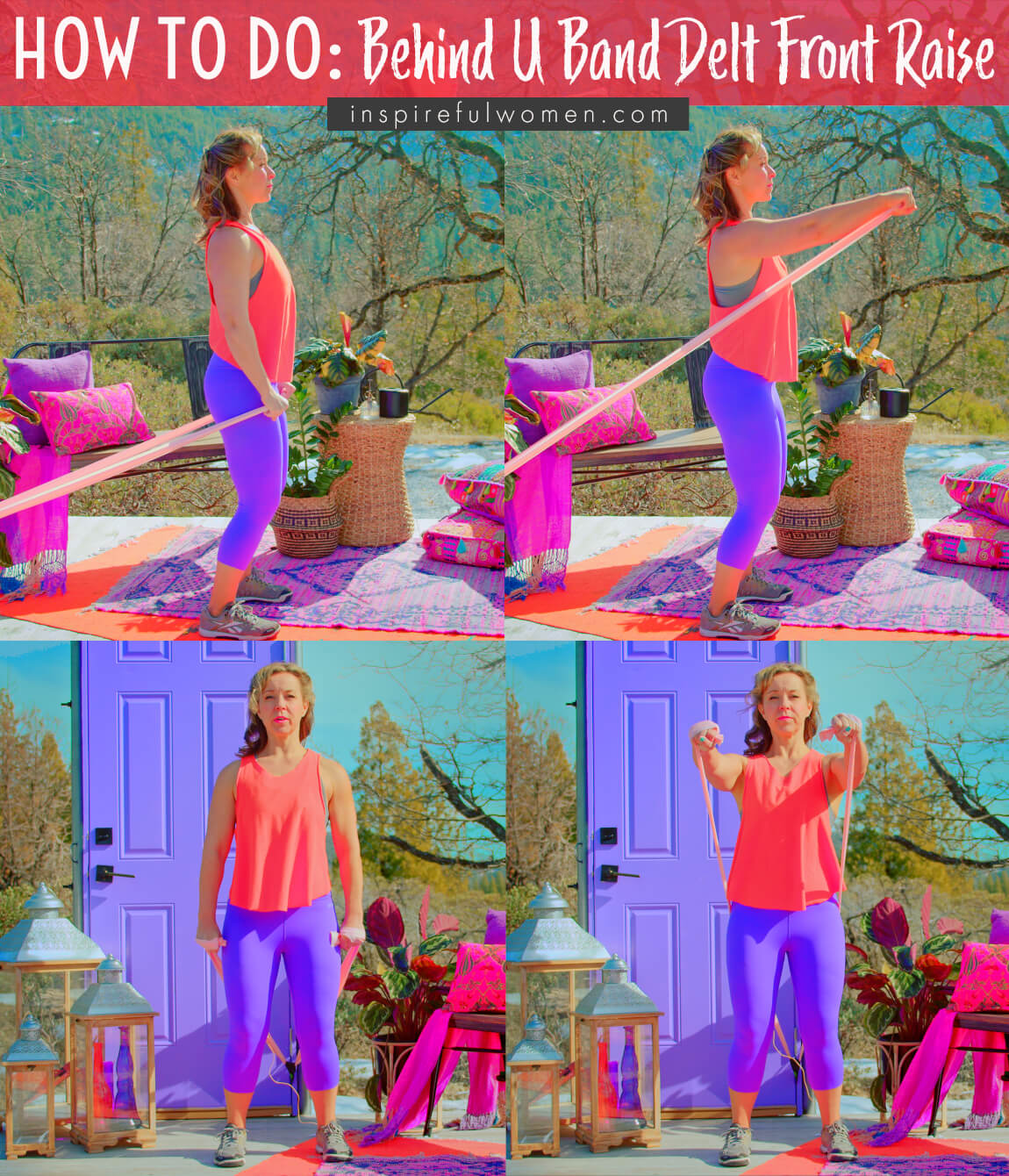


COMMON MISTAKES
COMMON MISTAKES
WHAT TO AVOID WITH THE Behind U Band Front Delt Raise
KEY TIP:
Guess what? Good news! Many avoids are the same for most movements. Once you learn the basics, there's really only a few extra avoids for each individual movement.
1. Avoid Rounding Shoulders
AVOID: Avoid letting the shoulder round inwards during the exercise.
WHY NOT?
- This contributes to your rotator cuff muscle - the supraspinatus, and biceps tendon, being pinched in the top of the shoulder.
WHAT TO DO:
- Think about keeping your shoulder blades down and back.
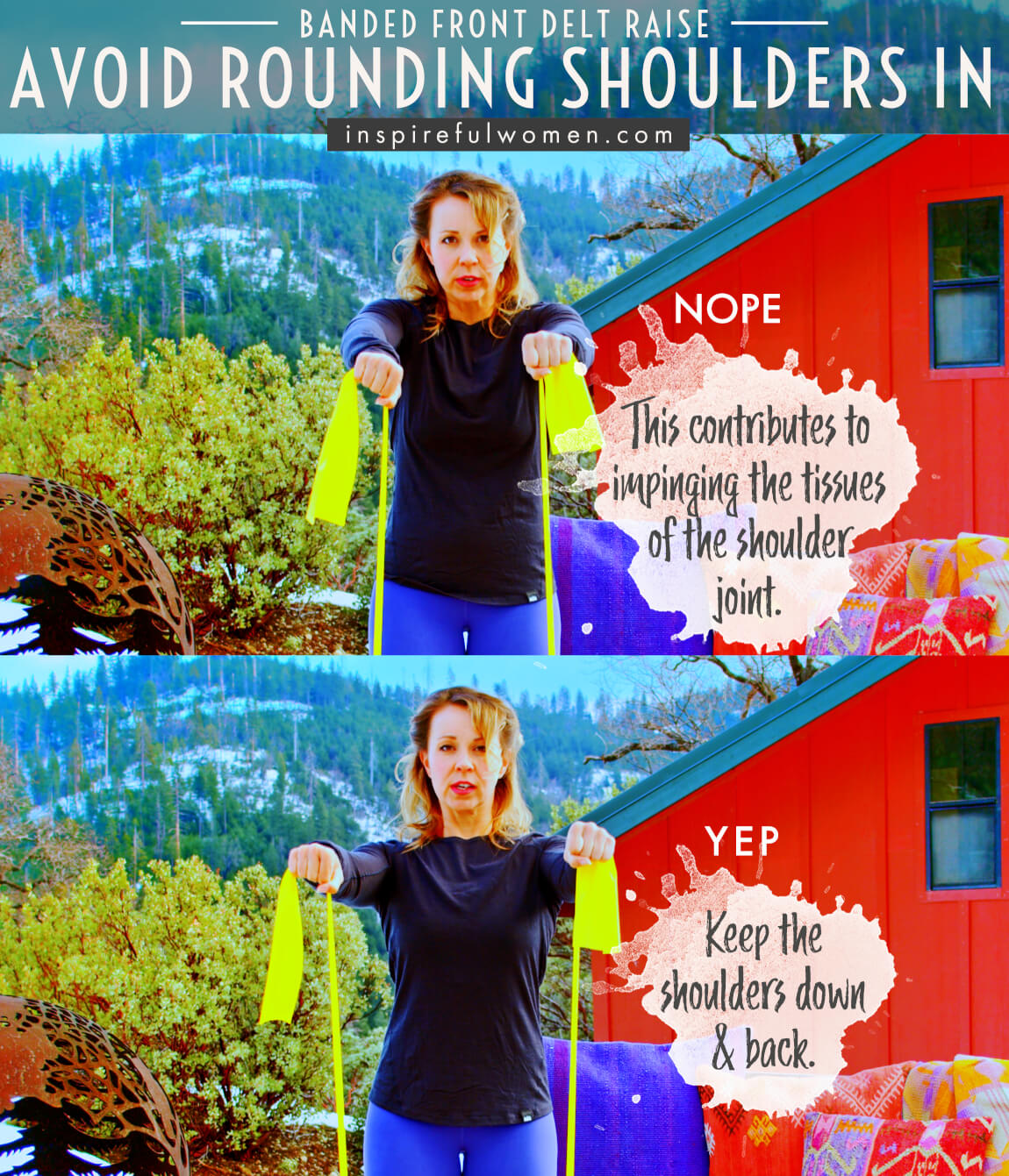
2. Avoid Moving Through Spine
AVOID: Avoid moving through the spine.
WHY NOT?
Moving through the spine repetitively, especially when holding weight, can result in muscle strain, and over time, can damage the ligaments and discs that stabilize the spine.
WHAT TO DO:
You want the torso to remain still during the entire exercise, so that the movement is only at the shoulder joint.

3. Avoid Lifting Higher Than Shoulder
AVOID: Avoid lifting the arms higher than shoulder height.
WHY NOT?
- The reason for this is is that after you reach 90 degrees of shoulder flexion, the torque on the shoulder decreases, and the risk for impingement increases. The risk of injury outweighs the benefit. All this means is the movement feels easier (meaning it's not working the muscles as hard now), WHILE also being more likely to injure you. So basically a pointless idea eh!
WHAT TO DO:
- Lift only up to your shoulder height.
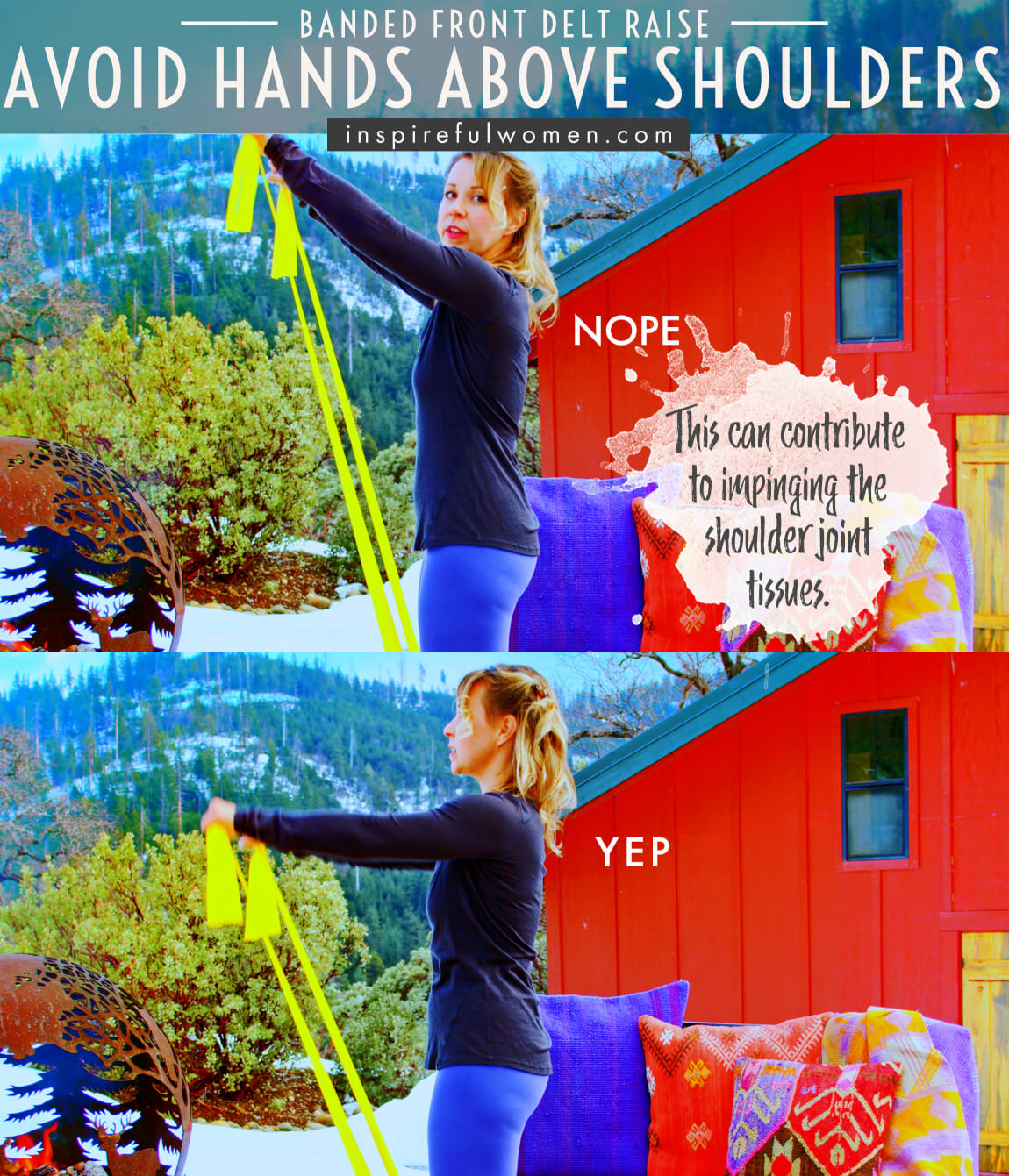
4. Avoid Straightening The Knees
AVOID: Straightening the knees
WHY NOT?
- Straightening the knees can make it difficult to keep your spine in neutral.
- Not maintaining a neutral spine position can lead to injury or muscle strain.
WHAT TO DO:
- Keep a soft bend in the knees
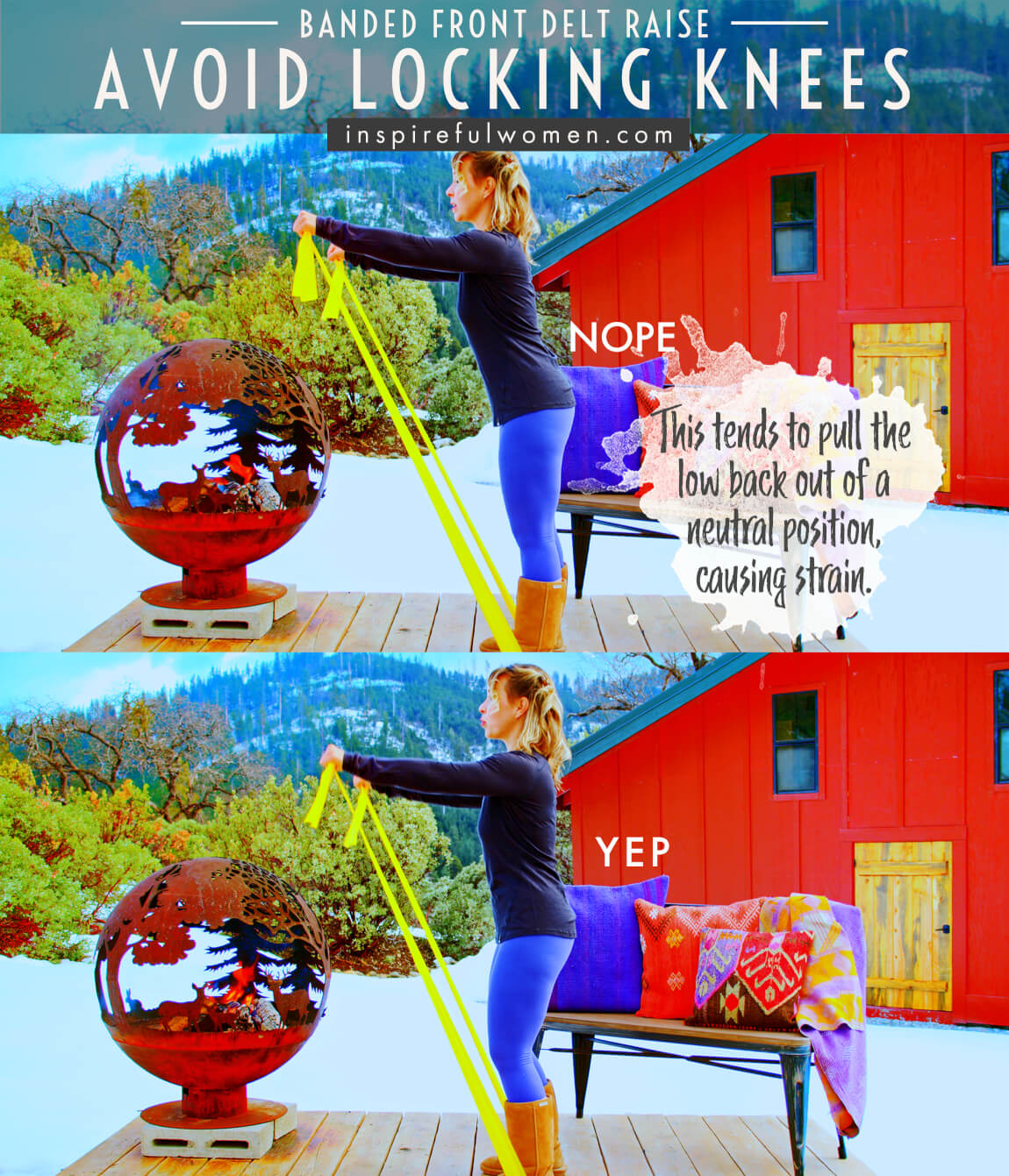
5. Avoid Bending Wrists
AVOID: Bending your wrists.
WHY NOT?
- Poor alignment (bent forward or backward) or repetitive movement through the wrist can lead to joint and/or soft tissue irritation or injury over time.
WHAT TO DO:
- Your wrists should be in line with your forearm and should be still throughout the exercise.
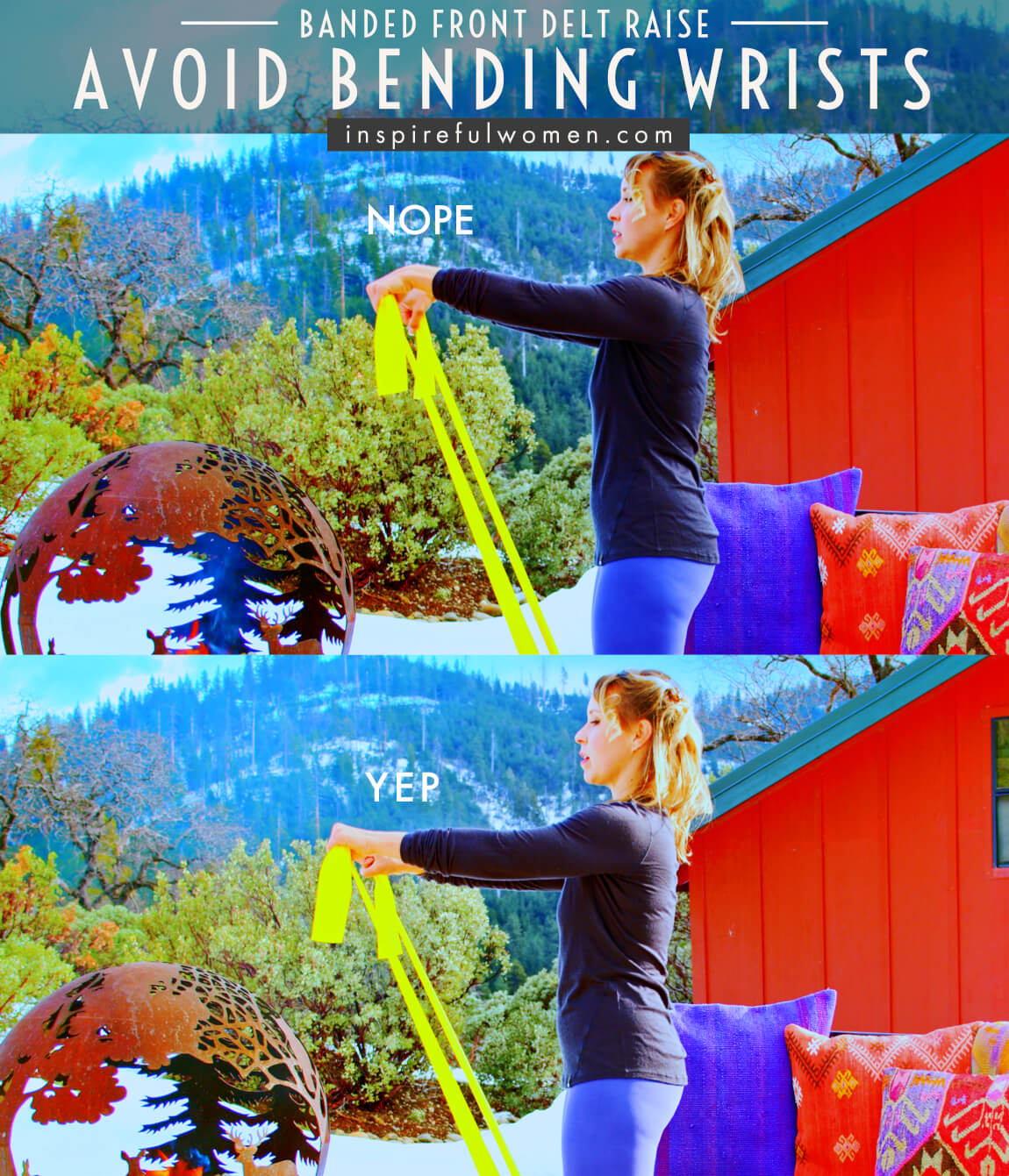
WHAT WE'RE DOING TODAY
WHAT & WHY
BENEFITS OF TRAINING THE Front DELT
WHAT
This will train the front part of the largest muscle in the shoulder - the deltoid. We (who I am kidding? Not we - I should say they - the sciency workout people - call this front area of the muscle the anterior deltoid. People more like us call it the front delt. Or maybe just the front of the shoulder eh!
Our arms are lifted up until they are level with your shoulders and then slowly lowered back down with control. The front part of the deltoid muscle will work in two different ways:
- while you lift the arm (concentric) and
- also while you lower the arm (eccentric)
WHY BOTHER DOING IT?
WHY
WHY DO WE EVEN CARE?
THIS MUSCLE DOES MOST THE WORK TO MOVE OUR ARMS EVERY DAY
The shoulder has one big muscle that is most responsible for moving the arm - that is the deltoid muscle. This muscle will get help from other muscles - but it does most of the work. Different parts of the muscle will lift the arm in different directions - the front part of the deltoid lifts the arm out to the front of the body. We lift or hold our arms out to the front all day long. Exercising the front deltoid will improve our ability to lift, hold and carry heavy objects.
HELPS PREVENT SHOULDER INJURIES
All of the parts of the deltoid muscle have to work together to protect the shoulder joint from damage, and exercising the this muscle in a safe way can help prevent shoulder injuries.
SAFER WAY TO TRAIN THIS MUSCLE
The front delt raise is one of the easiest and safest exercises for targeting this part of the muscle. This is a great way to train this muscle without raising our arms overhead which tends to become more problematic for women like us over 40. Not saying we shouldn't do it, just that we have to be more cautious about it and it may no longer be the main thing we do all the time.
So because this movement only brings out arms to shoulder height it is a safer position for us, less likely to cause injury or inflammation.
It is also very easy to modify the exercise to make it more or less challenging.
EVERYDAY LIFE
EVERYDAY LIFE &
MUSCLE FUNCTION
HOW WE USE OUR ANTERIOR DELTOID MUSCLES IN EVERYDAY LIFE
1. LIFTING ARM STRAIGHT UP IN FRONT OF BODY (FROM SHOULDER JOINT)
This muscle is used for lifting all items in front of the body when the movement comes from the shoulder (as opposed to bending the elbow) - meaning your elbow is raising into the air to some degree in front of you.
Examples:
- Lifting a jug of milk out of the fridge
- Lifting a pan from the oven
And many renovating skills!
- Spray painting
- Painting walls with rollers & paint brushes
- Slapping on drywall mud to fix those holes in the walls when your grown kids move out.
- Hammering a nail into a wall above you to hang that adorable picture of your 3 year old daughter/ granddaughter.
2. ROTATE ARM INWARD AT THE SHOULDER (INTERNAL SHOULDER ROTATION)
I found this one hard to understand myself when I was first learning it. The best way I can explain it is hold the top of your opposite shoulder with your fingers. The arm of the shoulder you're holding is just resting at your side with your elbow bent. Now move that elbow away from you out to the side/a little to the front. When you do this, what you feel happening with your fingers at your shoulder is your arm bone internally rotating in the shoulder joint.
Examples (if you do these things with moving your elbow outwards):
- Turning a screwdriver
- Turning off a water spigot
- Cleaning - wiping down counters with a sponge where you're moving in clockwise motions.
3. HOLDS ARM BONE IN SHOULDER JOINT AGAINST DOWNWARD PULLS
When the arm is hanging straight down by the side and holding a weight, the deltoid as a whole helps to hold the arm in the shoulder joint against the downward pull of the weight.
If the muscles didn't do this, the weight of what we held could pull the arm bone down in the joint and stretch out the ligaments and soft tissues that help to stabilize the joint. An unstable joint (sloppy movement in the joint) can lead to wear on the bony surfaces, and eventually pain, limited movement and weakness.
Examples:
- Carrying groceries
- Carrying buckets
4. HOLDING ARMS OUT IN FRONT OF YOU FOR SUSTAINED LENGTHS OF TIME
The muscle also holds the arm in front of you for longer periods of time - this is called being in a position of flexion, for activities such as reaching and turning - a key, doorknob, spigot faucet, lightbulb, wrench, screwdriver. Especially when turning the arm inwards at the same time. Also used for carrying items in the front for long periods of time:
- Your kiddo/grandkiddo
- Laundry basket,
- Wheelbarrow
- Boxes held from underneath as we traipse from the living room up the stairs to the attic to keep all those keepsakes forever
SCIENCY STUFF
SCIENCY STUFF
SPIFFILICIOUS FACTS ABOUT MUSCLES & MOVES
This is a good exercise for isolating the anterior portion of the deltoid muscle. The movement is isolated to the shoulder joint in the sagittal plane (moving straight forwards and back down). In this position, there will be minimal contribution from the pectoralis major, coracobrachialis, and biceps brachii - most of the effort will come from the anterior deltoid.
ALLLL MUSCLES & WHEN
ALL MUSCLES WORKING & WHEN DURING Behind U Band Front Delt Raises
The core stabilizers work to hold the spine in a neutral position throughout the exercise.
The movement of the arms begins with the arm straight down to the side. The scapular stabilizers will be active to hold the shoulder blades down and in, although not as much as when the band is anchored in front of you. The anterior deltoid along with the biceps, coracobrachialis, and upper fibers of the pectoralis major contract concentrically to lift the arm straight up in front of the body, until the arm is parallel or close to parallel with the floor.
The muscles of the forearm (extensor carpi radialis longus and brevis, extensor carpi ulnaris) will work isometrically to hold the wrist in a neutral position against the downward pull of the band.
The anterior deltoid, biceps brachii, coracobrachialis, and superior fibers of the pectoralis major work eccentrically to lower the arm back down to the starting position.
PIN IT FOR LATER!
